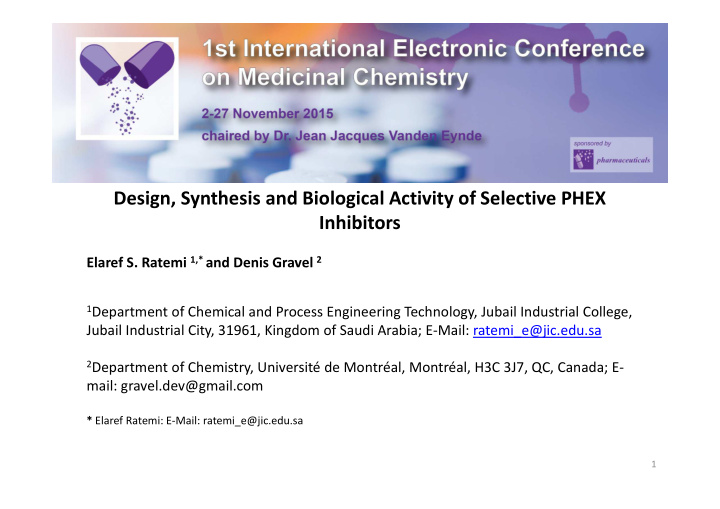



Design, Synthesis and Biological Activity of Selective PHEX Inhibitors Elaref S. Ratemi 1,* and Denis Gravel 2 1 Department of Chemical and Process Engineering Technology, Jubail Industrial College, Jubail Industrial City, 31961, Kingdom of Saudi Arabia; E-Mail: ratemi_e@jic.edu.sa 2 Department of Chemistry, Université de Montréal, Montréal, H3C 3J7, QC, Canada; E- mail: gravel.dev@gmail.com * Elaref Ratemi: E-Mail: ratemi_e@jic.edu.sa 1
Design, Synthesis and Biological Activity of Selective PHEX Inhibitors Graphical Abstract d e zinc binding l e t i o n p r group o e t d e u n c c y e s 2
Abstract: Here we report on the design, synthesis, and in vitro biological activity of mercaptoacyl dipeptide-based inhibitors of PHEX. A parallel solid phase peptide synthesis approach was used for producing focused compound libraries resulting in single digit nanomolar PHEX inhibitors. Structure activity relationships studies revealed that the P1’ aspartic acid residue is critical and its deletion or modification lead to a large decrease in activity. The stereochemistry of the aspartic acid residue at P1’ is also important. Replacing L-aspartic acid with its D enantiomer led to about a seven fold loss of potency. We explored multiple sites of diversity around the central aspartic acid and these results are also reported. In assessing selectivity for PHEX versus NEP, all the derivatives tested were highly selective for PHEX. Such compounds may have potential usage in regulating bone mineralization and/or as osteogenic agents. Keywords: Osteogenesis; bone mineralization; peptide synthesis; PHEX inhibitors 3
Introduction • Osteogenesis is a complex biological process that includes: � proliferation and differentiation of bone-forming cells (osteoblasts), � synthesis of an organic matrix composed mainly of type I collagen, and � mineralization of the organic matrix by deposition of hydroxyapatite crystals. • X-linked hypophosphatemic rickets (XLH), a human genetic disease, results from mutated PHEX gene. • XLH is characterized by under mineralization of the bone extracellular matrix. 4
Introduction • Several experimental observations support a role for PHEX in mineralization : � PHEX mRNA was detected in bones by Northern blot hybridization. � A soluble form of PHEX inhibits mineralization of rat calvaria osteoblast cultures. • Thus, PHEX is involved • Decreasing PHEX peptidase activity with specific inhibitors might therefore potentiate the mineralization process 5
Results and discussion Subsite Specificity of PHEX: PHEX shows a very restricted specificity for its S' 1 and S' 2 • • Several putative PHEX substrates (approximately 15 different peptides) were tested but only PTHrp 107-139 was cleaved. • PTHrp 107-139 cleavage: Specificity of the S’1 pocket of PHEX 8 T R S A W L D S G V T G S G L E G D H L S D T S T T S L E L D S R 7 P 1 ' 6 5 * k cat /K m 4 3 • Strong specificity of the S' 1 pocket 2 for D (aspartic acid). 1 0 KRHGA V L I PDE S TMNQF YW Amino Acid 6
Results and discussion Design and Synthesis of PHEX Inhibitors: 1 st generation • Design and prepare a lead based on the above PHEX substrate results • Prepare derivative 1 : it contains the P’1 aspartic acid side chain mimic, the thiol zinc-binding group, and serine in P’2 1 inhibited PHEX at 1 �� • Prepare a compound library with • a whole host of amino acids at P’2 CO 2 H O Activities ranged from low �� to sub �� H • N HS OH O OH 1 7
Results and discussion Design and Synthesis of PHEX Inhibitors: 2 nd generation • Explore the mercaptoacyl moiety as the zinc- binding group 2 3 • Prepare a compound library to explore P’1 (example: compounds 2 & 3) Activity still at the sub �� ����� • 8
Results and discussion Design and Synthesis of PHEX Inhibitors: 2 nd generation • Can we gain additional binding by introducing a ligand in S1 pocket? • Breakthrough: 60 fold increase in activity (compare compounds 2 and 4) 2 4 • Gained additional binding by the P1 pharmacophore 9
Results and discussion Design and Synthesis of PHEX Inhibitors: 2 nd generation • Optimize the P’1 site in presence of the P1 pharmacophore CO 2 H Compound IC 50 (nM) O AA HS 4 Trp 10 N H 5 Phe 70 O 6 Bi-Phe 38 7 2-naphthyl-Ala 6 8 Tyr 72 • Aromatic amino acids are well-tolerated 9 Ser 170 (compounds 4-7) 10 Pro >100000 • Removal of terminus CO 2 H reduces potency 11 Phenyl alaninol 90 (compounds 12 & 13) 12 Trptamine 140 13 Biphenyl methylamine 230 • Proline eliminates activity (compound 10) Suggesting importance of H-bonding and/or conformational constraints 10
Results and discussion Design and Synthesis of PHEX Inhibitors: 2 nd generation • Optimize the P1 pharmacophore Compound IC 50 (nM) 4 Benzyl 10 14 4-Methoxybenzyl 20 15 4-F-Benzyl 6 16 Phenyl 2 17 2-Naphthylmethyl 15 18 2-Indolylmethyl 23 19 Biphenmethyl 8 20 4-Benzoloxybenzyl 8 21 Phenethyl 4 very welcoming pocket 22 Methyl 68 23 Isopropyl 6 24 Isobutyl 94 25 n-Butyl 7 26 Cyclohexylmethyl 20 11
Conclusions • Potent and selective inhibitors were rationally designed and synthesized for the first time. • The P1 pharmacophore is a major contributor to the activity of the inhibitors of PHEX with clear preference to aromatic and alkyl substituents having the S stereochemistry. The P’1 sub-site is very restrictive with high specificity for L -aspartic • acid. • The P’2 sub-site shows clear preference for aromatic moieties and modification or deletion of the carboxyl terminus at this site leads to loss in potency. 12
Acknowledgments $$$$$ � This work was financially supported in part by a grant from the National Research Council (Canada)-IRAP grant. � We thank Dr. Isabelle Lemire for help with some of the biological studies. 13
Recommend
More recommend